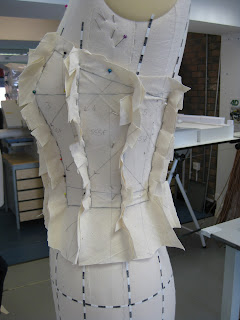This is all achieved by drape work. A small female tailors mannequin is needed. The number of pannels needed can vary, but as a rule of thumb the more pannels the better and closer the fit can be. The ballet bodice must fit the body of the dancer perfectly and cling to her like a second skin. The grain of the fabric is used to its best advantage and breaks some of the rules I am used to working with when making corsetry.
The blog however will be lacking in all the full details as I'm working in a sketchbook alongside this unit and creating a kind of "How To" package in there so I have a full record of the processes used and I should be able to come back to them again and again.
What I do have to share are photos of the pattern marked out in tape and then the pieces laid and pinned onto the mannequin. Once all marked up they are ready to be taken down, have their seams trued and then marked up with grain lines and piece numbers etc. ready to be used as a pattern- something else new to me, taking the calico pattern straight off the mannequin and using it to cut out top fabrics, without transferring it to paper first! Oh how I love to discover these little time saving processes, to make my life easier. :)








Best blog on corsets I've found yet. Thank you.
ReplyDeleteBest blog on corsets I've found yet. Thank you.
ReplyDelete